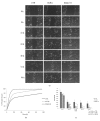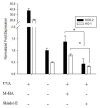Positive Effects against UV-A Induced Damage and Oxidative Stress on an In Vitro Cell Model Using a Hyaluronic Acid Based Formulation Containing Amino Acids, Vitamins, and Minerals
- PMID: 30046611
- PMCID: PMC6038662
- DOI: 10.1155/2018/8481243
Positive Effects against UV-A Induced Damage and Oxidative Stress on an In Vitro Cell Model Using a Hyaluronic Acid Based Formulation Containing Amino Acids, Vitamins, and Minerals
Retraction in
-
Retracted: Positive Effects against UV-A Induced Damage and Oxidative Stress on an In Vitro Cell Model Using a Hyaluronic Acid Based Formulation Containing Amino Acids, Vitamins, and Minerals.Biomed Res Int. 2021 Feb 18;2021:1975827. doi: 10.1155/2021/1975827. eCollection 2021. Biomed Res Int. 2021. PMID: 33728326 Free PMC article.
Abstract
Ultraviolet (UV) radiations are responsible for skin photoaging inducing alteration of the molecular and cellular pathways resulting in dryness and reduction of skin elasticity. In this study, we investigated, in vitro, the antiaging and antioxidant effects of hyaluronan formulations based hydrogel. Skinkò E, an intradermic formulation composed of hyaluronic acid (HA), minerals, amino acids, and vitamins, was compared with the sole HA of the same size. For this purpose, HaCaT cells were subjected to UV-A radiations and H2O2 exposure and then treated with growth medium (CTR) combined with M-HA or Skinkò E to evaluate their protective ability against stressful conditions. Cells reparation was evaluated using a scratch in vitro model and Time-Lapse Video Microscopy. A significant protective effect for Skinkò E was shown with respect to M-HA. In addition, Skinkò E increased cell reparation. Therefore, NF-kB, SOD-2, and HO-1 were significantly reduced at the transcriptional and protein level. Interestingly, γ-H2AX and protein damage assay confirmed the protection by hyaluronans tested against oxidative stress. G6pdΔ ES cell line, highly susceptible to oxidative stress, was used as a further cellular model to assess the antioxidant effect of Skinkò E. Western blotting analyses showed that the treatment with this new formulation exerts marked antioxidant action in cells exposed to UV-A and H2O2. Thus, the protective and reparative properties of Skinkò E make it an interesting tool to treat skin aging.
Figures







References
-
- Thiesen L. C., Baccarin T., Fischer-Muller A. F., et al. Photochemoprotective effects against UVA and UVB irradiation and photosafety assessment of Litchi chinensis leaves extract. Journal of Photochemistry and Photobiology B: Biology. 2017;167:200–207. doi: 10.1016/j.jphotobiol.2016.12.033. - DOI - PubMed
Publication types
MeSH terms
Substances
LinkOut - more resources
Full Text Sources
Other Literature Sources
Medical

